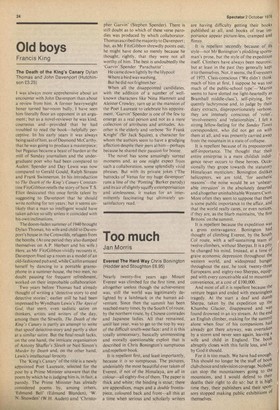Too much
Jan Morris
Everest The Hard Way Chris Boni ngton (Hodder and Stoughton £6.95) Nearly twenty-five years ago Mount Everest was climbed for the first time, and altogether useless though the achievement was, still the world was legitimately delighted by a landmark in the human adventure. Since then the summit has been reached many times, by the South Col route, by the northern route, by Chinese comrades and Japanese ladies. All that remained, until last year, was to get to the top by way of the difficult south-west face: and it is this totally unnecessary, basically uninteresting and morally questionable exploit that is described in Chris Bonington's sumptuous and repellent book.
It is repellent first, and least importantly, because it is so sumptuous. The pictures, undeniably the most beautiful ever taken of Everest, if not of the Himalaya, are all in colour—all eighty-five of them. The paper is thick and white; the binding is stout; there are appendices, maps and a double frontispiece, coloured back and front—all this at a time when serious and scholarly writers
are having difficulty getting their books published at all, and books of true importance appear picture-less, cramped and flimsy.
It is repellent secondly because of its style—not Mr Bonington's plodding sportsman's prose, but the style of the expedition itself. Climbers have always been neurotic, but at least in the past they generally kept it to themselves. Not, it seems, the Everesters of 1975. Class-conscious ('We didn't think much of him at first. I suppose he was too much of the public-school type'—' Martin seems to have slotted me light-heartedly as Bramhall middle-class"), self-pitying, frequently lachrymose and, to judge by their diary extracts, disproportionately verbose, they are intensely conscious of 'roles', 'involvements' and 'relationships'. I felt a strong fellow-feeling for the Sunday Times correspondent, who did not get on with them at all, and was presently carried away from the mountain in a state of collapse.
It is repellent because of its preposterous self-importance. The thought that their entire enterprise is a mere childish indulgence never occurs to these heroes. Occasionally they grope towards the statutory Himalayan mysticism: Bonington dislikes helicopters, we are told, 'for aesthetic reasons'—the noise would be an 'unbearable intrusion' in the absolutely deserted and altogether uninhabitable Western Cwm• More often they seem to suppose that there is some public importance to the affair, and that the world really cares, or even notices. if they are, as the blurb maintains, 'the first Britons' on the summit.
It is repellent because the expedition was a gross extravagance. Bonington had thought of climbing Everest, by the South Col route, with a self-sustaining team of twelve climbers, without Sherpas. It is a pity he changed his mind. Instead, at a time of grave economic depression throughout the western world, and widespread hunger throughout the east, he took twenty-three Europeans and eighty-two Sherpas, equiPped with every conceivable aid to mountain convenience, at a cost of £100,000.
And most of all it is repellent because the venture began and ended with meaningless tragedy. At the start a deaf and dumb Sherpa, taken by the expedition up the Khumbu Glacier, disappeared and was found drowned in an icy stream. At the end an English climber, making for the summit alone when four of his companions had already got there anyway, was overtaken by a storm and never seen again, leaving a wife and child in England. The book abruptly closes with this futile loss, and so by God it should. For it is too much. We have had enough• This should no longer be the stuff of book club choice and television coverage. NobodY can stop • the mountaineers going to the mountains, and I would defend to ther deaths their right to do so: but it is high time they, their publishers and their sponsors stopped making public exhibitions of themselves.


































 Previous page
Previous page